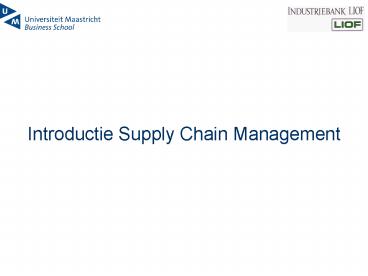Introductie Supply Chain Management - PowerPoint PPT Presentation
1 / 28
Title:
Introductie Supply Chain Management
Description:
Time to market (Personal computers), Supply chain leadtime (Mobile phones), customization (Cars) ... HP/Compaq 15.5% Source: Gartner Dataquest. How SCM ... – PowerPoint PPT presentation
Number of Views:106
Avg rating:3.0/5.0
Title: Introductie Supply Chain Management
1
Introductie Supply Chain Management
2
What is a supply chain?
Customer
4PL
the supply chain
3 PL
3 PL
Value chains
Carrier
Carrier
Carrier
Carrier
Trailer service
ICT host
Hardware provider
3
Opprtunities Threats
More product introductions and products for
unfaithful customers Tougher competition
- Shorter product life cycles
- Customization
- Globalization
- Outsourcing
Longer chains, more parties involved, tougher
competitors Tougher supply chain management
4
Consequenses for ICT
- Handling information of more products
- Handling more changes in product information
- Handling more customers, and changing customers
(installed base) - Longer chains, more parties more information
exchange for managing the chain
5
Weaknesses Strength
- The ability to succesfully implement contemporary
supply chain management principles - The ability to succesfully implement contemporary
supply chain management technology - sustainable competitive advantage
6
Customer Order Decoupling Point Make to Stock
Make to Stock
Push
7
Customer Order Decoupling Point Engineer to
Order
Engineer to Order
8
Customer Order Decoupling Point Assemble to
Order
Make to Stock
Assemble to order
9
Assemble to Order
- High volume low cost upstream from CODP
- Customization downstream from CODP
- Mass customization Best of both worlds
- Mass customization requires more information
technology!
10
Who is in charge in the value chain?
- The one who interacts with the CUSTOMER!
- Walmart
- Proctor Gamble
- Nike
- The one who has the unique feature in the PRODUCT
or SERVICE! - Intel
- Fedex
11
Competition takes places at the end customer
market!
- Choose a market Target your strategy on end user
markets and make it measurable in Key Performance
Indicators regarding the customer market. - Competitive strategies according to Porter
- Cost leadership Price based competition, low
production and logistics costs - Differentiation Quality based competition,
productportfolio, time to market. - Focus Target a niche market
12
From market strategy to corporate strategy
SC strategy
KPIs!
2nd tier supplier
1st tier (main) supplier
Distributor
Retailer
Corporate strategy
KPIs!
3 PL
Strategy sec. processes
Trans
KPIs!
ICT host
Hardware
13
Market performance indicators
- Cost leadership
- Price
- Total cost of ownership for customer
- Differentiation oriented
- Product quality,
- Service level,
- After sales services
- Delivery time,
- Product image.
14
Supply chain performance
- Cost leadership
- cost of goods sold
- overhead costs per unit, consolidated
- Obsolescence costs (apparel),
- inventory cost (CODP, High Tech)
- manufacturing costs (consumer electronics),
- cash to cash cycle times (retail).
- Differentiation
- Time to market (Personal computers),
- Supply chain leadtime (Mobile phones),
- customization (Cars),
- Flexibility, productportfolio
Inventory is bad! Inventory hides problems
15
Corporate performance
- Same as supply chain performance indicators,
however - Beware of the COPD, the upstream KPIs may differ
from the downstream KPIs (and then the COPD is a
tough position) ! - Beware of local optimization pie sharing versus
pie growing! - Unfortunatelyyou are in more than one chain, and
different chains have different priorities!
16
Fishers supply chain fit matrix
17
Enhancing performance through state of the art
SCM concepts
- Postponement Move the CODP upstream (reduces
inventory)! - Cross Docking reduces inventory and lead times
- Vendor Managed Inventory reduces inventory and
replenishment costs - Strategic alliances fair shares!!!
18
Enhancing performance through state of the art
technology
- Share (market) information through the supply
chain trade inventory for information - Organize visibility monitor alert on KPIs.
- Plan and schedule according to supply chain
KPIs Collaborative Planning Forecasting and
Replenishment. - Technology brings new SCM concepts within reach
19
Benettons innovation postponement
20
Benettons innovation postponement
21
Benettons score
- Market
- Better collection in store (customization)
- Lower price
- Better response
- Supply chain
- Lower inventory costs
- Lower obsolescence costs
- Higher production costs
- Integration with Logistic Service Provider
22
Dells innovation assemble to internet order
23
(No Transcript)
24
(No Transcript)
25
(No Transcript)
26
Dells score
- Market
- Low price
- Extreem fast delivery
- Customization
- Market share
- Supply chain
- Negative cash to cash cycle time!
- Less pie eaters, more pie!
- Higher fulfillment cost
- Zero inventory
- Full supplier and LSP integration, on planning,
scheduling and execution level
27
Facts Figures
PC market shares Q4 2003 Dell 16.0 HP/Compaq
15.5 Source Gartner Dataquest
28
How SCM Technology becomes a competitive
advantage?
- Be in chains that are winners on the end user
market, measure in end user market KPIs - Target Supply chain and corporate KPIs in terms
of market KPIs. - Use state of the art competitive weapons (your
competitors do!) - SCM concepts, if they supports the SC strategy
- ICT, if it supports the SC strategy
- Think strategically, pie growing, not pie sharing































